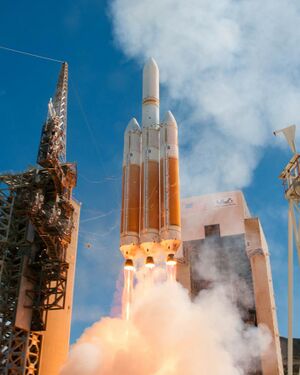Engineering:USA-245
 Launch of USA-245 | |
| Mission type | Optical imaging |
|---|---|
| Operator | National Reconnaissance Office |
| COSPAR ID | 2013-043A |
| SATCAT no. | 39232 |
| Spacecraft properties | |
| Spacecraft type | KH-11 |
| Manufacturer | Lockheed Martin |
| Start of mission | |
| Launch date | 28 August 2013 18:03:00 UTC |
| Rocket | Delta IV Heavy (Delta 364) |
| Launch site | Vandenberg Air Force Base , SLC-6 |
| Contractor | United Launch Alliance |
| Orbital parameters | |
| Reference system | Geocentric orbit |
| Regime | Sun-synchronous orbit |
| Slot | West plane |
| Perigee altitude | 276 kilometres (171 mi) |
| Apogee altitude | 1,010 kilometres (630 mi) |
| Inclination | 97.86° |
| Period | 97.44 minutes |
| Epoch | 8 January 2015 19:32:46 UTC[1] |
USA-245 or NRO Launch 65 (NROL-65) is an American reconnaissance satellite which is operated by the National Reconnaissance Office. Launched in August 2013, it is the last Block 4 KH-11 reconnaissance satellite, and the last official spacecraft to be launched in the Keyhole program.[2]
Reconnaissance satellite
Details of USA-245's mission are classified by the US military, however numerous independent analysts identified it as a KH-11 before launch, and amateur satellite watchers have since observed it in the orbit used by such satellites.[3][4]
KH-11 satellites are used to provide high-resolution optical and infrared imagery for US intelligence agencies.[5]
USA-245 was launched by United Launch Alliance, using a Delta IV Heavy rocket[6] with the flight number Delta 364 and the name Victoria. The launch took place from Space Launch Complex 6 at the Vandenberg Air Force Base at 18:03 UTC (11:03 local time) on 28 August 2013.[7] After deploying its payload, the rocket's upper stage was deorbited after completing one orbit.[2] The launch was the first Delta IV mission to use a new ignition sequence aimed at reducing damage to the first stage insulation caused by igniting a cloud of hydrogen around the vehicle at liftoff. To mitigate this, the rocket's starboard engine was lit two seconds earlier than on previous flights.[8]
In 2020, MIT Technology Review reported that USA-245 was likely being "stalked" by a Russian satellite, Kosmos 2542, in a possible attempt to spy on US-245 to deduce its camera aperture and resolution, or its computer functionality and operating times.[9]
References
- ↑ Peat, Chris (8 January 2015). "USA 245 - Orbit". http://www.heavens-above.com/orbit.aspx?satid=39232.
- ↑ 2.0 2.1 Graham, William (28 August 2013). "ULA Delta IV-H launches with NROL-65". http://www.nasaspaceflight.com/2013/08/ula-delta-iv-h-launch-nrol-65/.
- ↑ Molczan, Ted (28 August 2013). "RE: NROL-65 search elements". Seesat-L. http://satobs.org/seesat/Aug-2013/0184.html.
- ↑ Langbroek, Marco (28 August 2013). "NROL-65 seen". Seesat-L. http://satobs.org/seesat/Aug-2013/0188.html.
- ↑ Krebs, Gunter. "KH-11 / Kennen / Crystal". http://space.skyrocket.de/doc_sdat/kh-11.htm.
- ↑ "National Reconnaissance Office Mission Successfully Launches on World's Largest Rocket, the United Launch Alliance Delta IV Heavy". 28 August 2013. http://www.ulalaunch.com/site/pages/News.shtml#/152/.
- ↑ Ray, Justin (28 August 2013). "Delta Launch Report - Mission Status Center". http://www.spaceflightnow.com/delta/d364/status.html.
- ↑ Ray, Justin (25 August 2013). "America's largest rocket set for launch Wednesday". http://www.spaceflightnow.com/delta/d364/preview.html.
- ↑ Patel, Nell V. (2020-02-03). "A Russian satellite is probably stalking a US spy satellite in orbit" (in en). MIT Technology Review. ISSN 0040-1692. OCLC 37630163. https://www.technologyreview.com/2020/02/03/349146/a-russian-satellite-is-probably-stalking-a-us-spy-satellite-in-orbit/. Retrieved 2021-10-07. "On January 20, something rather strange happened in orbit. A Russian satellite suddenly maneuvered itself so that it was closely shadowing a US spy satellite. The pair are now less than 186 miles (300 kilometers) apart—a short distance when it comes to space. While we don’t know for sure what’s going on, the Russian satellite’s actions strongly suggest it is there to spy on the US one—and there is very little the US can do about it.".
 |

